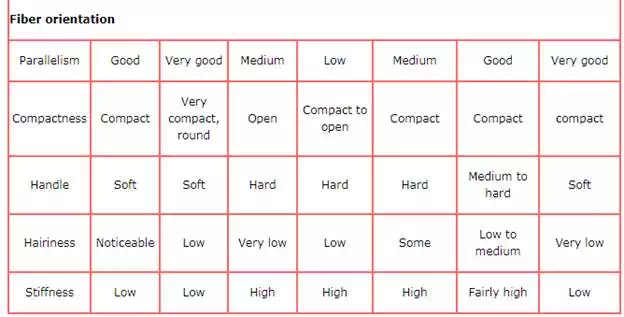The Positions of the fibers in the yarn structure

Owing to the twist, all or some of the fibers take up the required helical disposition. The number of fibers affected by the twist, and the degree of winding, are strongly dependent upon the spinning process.
In ring-spun yarns, twisting takes place from the outside inwards. At the periphery (the outer sheath A, Fig.2), owing to the greater degree of winding, the fibers have a lesser inclination, ( γ = angle between the fibers and the axis of the yarn) than in the interior of the yarn (the core B).
Since the fibers become steadily less tightly wound towards the core, ring-spun yarn may be said to have sheath-twist. Under loading, the outer layers will tend to take the radial forces and the inner layers will tend to take the axial forces.
However, by increasing pressure inwards, the radial forces reinforce axial resistance to sliding apart of the fibers. Accordingly, fully twisted yarns with sheath-twist have high tensile strength but are not so resistant to abrasion.
Under abrasion the outer, highly tensioned fibers are destroyed. Since these fibers hold the yarn together, the strand loses its cohesion. Hairiness on the yarn surface is mainly caused by protruding shorter fibers.
Yarn Structure
One aspect of structure is the visual appearance, created solely by the peripheral layer of the yarn, and a second aspect is the internal and external make-up. Yarn structures are very variable. The differences are partly deliberately caused, depending on the intended use of the yarn, but for the most part they are predetermined by the means available.
For example, it is difficult to produce a yarn equivalent to a ring-spun yarn by the new spinning processes – and the ring-spun yarn still represents the standard of comparison (Table.1).
The yarn structure is dependent primarily upon the raw material, spinning process, spinning unit, machine, machine settings, twist, etc. The structure can be open or closed; voluminous or compact; smooth or rough or hairy; soft or hard; round or flat; thin or thick, etc.


But yarn structure is not simply appearance. It has a greater or lesser influence on:
· handle;
· strength;
· elongation;
· insulating capacity;
· covering power;
· ability to resist wear, damage, strains, etc.;
· resistance to abrasion;
· ability to accept dye;
· tendency towards longitudinal bunching of fibers;
· Wearing comfort, etc.